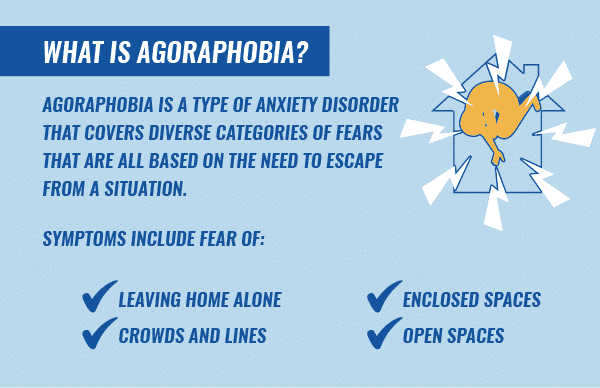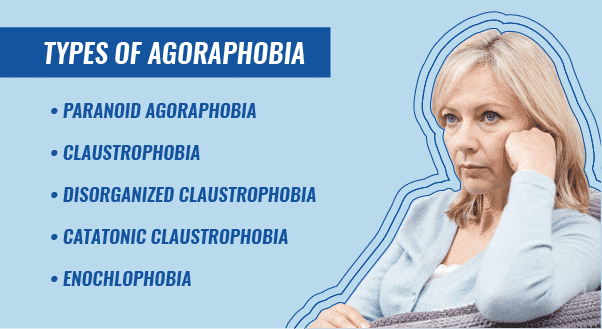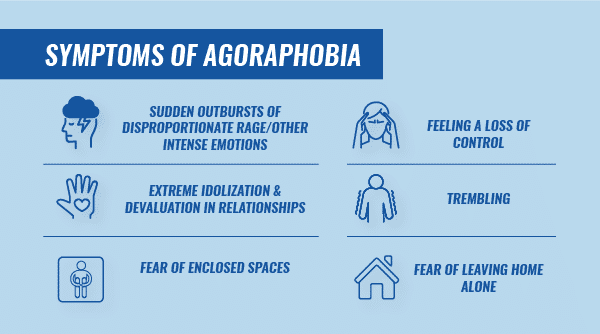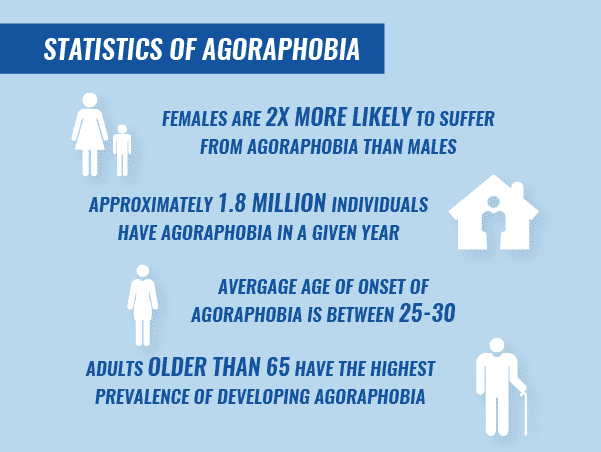Agoraphobia causes people to avoid places and situations where they might feel trapped, helpless, panicked, embarrassed or out of their comfort zone.
Living with agoraphobia can be very challenging. People who have this disorder deal with anxiety in actual or anticipated situations. As a result, they may not allow themselves to leave their places of comfort. If left untreated, agoraphobia can cause people to experience severe bouts of anxiety regularly.
What Is Agoraphobia?
Agoraphobia is ananxiety disorderthat covers diverse categories of fears associated with a desire to escape from a situation that makes the individual uncomfortable. Agoraphobia causes people to avoid places and situations where they might feel trapped, helpless, panicked, embarrassed or out of their comfort zone.
An individual struggling with agoraphobia often fears embarrassing themselves in public or experiencing a panic attack in a social setting. The fear can develop so intensely that the individual will avoid leaving their home, even when in need of medical care. They often have a fear of leaving their house and a fear of going outside.
Many individuals dealing with agoraphobia fear to be alone, leaving home, experiencing public humiliation, being in crowded situations or being in a confined place, such as an elevator, car, plane, subway or boat.
[elementor-template id="4848"]Agoraphobia not only affects the person who experiences the disorder, but it also affects their loved ones, job and social life.
Related Topic:Agoraphobia treatment

Types of Agoraphobia
Fear of crowds is one of the numerous types of agoraphobia. While most people dislike crowded places, an individual who struggles with agoraphobia might feel severe anxiety at a concert, where they may search for a way out or away from the crowd, in a panic.
Panic disordersand agoraphobia are closely related. In the American Psychiatric Association’s Diagnostic and Statistical Manual of Mental Disorders (DSM), the diagnostic manual used by psychiatrists, psychologists and other mental health professionals, two types of agoraphobia include panic disorder with agoraphobia and agoraphobia without a history of panic disorder.
Additionally, different forms of agoraphobia include:
- Paranoid agoraphobia
- Claustrophobia
- Disorganized agoraphobia
- Catatonic agoraphobia
- Enochlophobia
The difference between the two diagnosable types of agoraphobia is the presence of a panic disorder or frequent panic attacks.
Paranoid Agoraphobia
Paranoid agoraphobia is a combination of two conditions: paranoia and agoraphobia. Paranoia is the presence of false beliefs or heavily concentrating on something that is true, which often causes someone to feel endangered or threatened. Agoraphobia, on the other hand, is an extreme fear of feeling out of your comfort zone and not being able to escape.
Paranoia and agoraphobia may seem similar, as both conditions involve extreme fear and a reluctance to leave home. However, paranoia is based on fixed, false beliefs. Conversely, agoraphobia is associated with a fear of having a panic attack or failing to receive help while in an uncomfortable situation.
Claustrophobia
Individuals suffering fromclaustrophobiafear small, confined spaces. Their extreme levels of anxiety cause them to avoid small spaces do to fight over being confined or trapped. Claustrophobia is a fairly common condition, which can dissipate or with effectivetreatment for claustrophobia.
Disorganized Agoraphobia
Because people with agoraphobia often have difficulty maintaining their mental and physical balance, they rely more on visual and tactical senses. Their visual and tactile signals can become distorted if incorrectly translated by the brain. The individual may feel like they are going to fall as they feel the wind blow while walking over a bridge. Because their sense of balance is not accurate, the communication between their five senses and their brain becomes disorganized and the person struggles to feel stable. This miscommunication can create severe panic.
Catatonic Agoraphobia
The catatonic state is a phrase used to describe the inability to move in an ordinary way. Catatonic agoraphobia causes an inability to speak or move when placed in a situation of fear. Picking up a jar, entering a room or rising from the sitting position can be difficult for these individuals. The person may panic and struggle to carry out tasks, which can be dangerous. For example, some people experience catatonic agoraphobia when attempting to drive across a bridge
Enochlophobia
Enochlophobia is a common social phobia that involves an irrational fear of large crowds. Women tend to be affected bythis condition more than men. Individuals withEnochlophobia tend to avoid events such as concerts and sporting events due to extreme worry.

Causes and Symptoms of Agoraphobia
Many people wonder, “What causes agoraphobia?” The causes of agoraphobia are not known. However, otheranxiety disorders, past traumatic experience orsubstance usemay contribute to the development of agoraphobia. Research has discovered that a link exists between agoraphobia and an individual’s ability to balance their body. Markedly, those with agoraphobia have great difficulty maintaining their balance and rely more on visual and physical abilities. The individual’s internal cues can become disorganized and confused, which can create severe panic.
Individuals with agoraphobia frequently have symptoms of a panic attack in situations that they fear. A primary symptom is an intense fear of being in places or situations that they do not want to be in.
Agoraphobia symptoms include:
- Hyperventilation
- Fear of humiliation
- Feeling a loss of control
- Nausea
- Dizziness
- Fear of a panic attack
- Depression
- Anxiety
Some physical symptoms for agoraphobia disorder include trembling, upset stomach, trouble swallowing, excessive sweating, diarrhea, dizziness and the ringing of the ears.
An individual who deals with agoraphobia will also have symptoms that affect their social life. Some of these symptoms include relationship and financial problems, reclusiveness anddrug or alcohol abusethat could bring about addiction.
In some cases, agoraphobia can prevent an individual from completing normal daily activities, such as going to the grocery store. Instead, many people with the condition stay inside their homes for most of the day.
Fear of Leaving Home Alone
The fear of leaving home is a symptom of agoraphobia that keeps a person from enjoying many aspects of life. This type ofOCDagoraphobia is a personal prison with invisible lines that cannot be crossed by the individual to keep them safe from their fears. While some will stay home to avoid having to cross a bridge, others may remain cooped up to avoid busy streets, crowded places, or being humiliated in public. Some patients with agoraphobia may only allow themselves to leave home with loved ones. However, there are severe cases that involve the inability to leave home at all because they feel that it is the only safe place.
Fear of Crowds
Enochlophobia is an irrational fear of congregations of people and large crowds, which is an aspect of agoraphobia. Being in crowded spaces can be noisy, disruptive and cause the individual to be so frightened that they might be unable to hear conversations with others and that their personal space will be violated. An individual who struggles with enochlophobia may not feel comfortable recognizing the emotions of strangers whom they are near in big crowds. This type of agoraphobia often causes an individual to avoid popular restaurants, concerts, subways, traffic, malls and museums.
Fear of Enclosed Space
Claustrophobia often causes people to fear being trapped in small spaces. An individual who struggles with claustrophobia will go to excessive lengths to avoid situations where they may find themselves in small spaces. Elevators, dressing rooms, locked rooms, tunnels, basements, cellars and trains or subways are off limits to an individual with claustrophobia. If the claustrophobic individual finds themselves in an enclosed area, panic and anxiety often occur. To avoid these situations, they may prefer to take the stairs rather than an elevator — even when there are numerous flights of stairs to their destination.
For these individuals, even thinking about being in a confined space can trigger fears of not being able to breathe deeply enough, running out of oxygen or the agony of being restricted.
Symptoms of claustrophobia include sweating and chills, increased heart rate, lightheadedness, hyperventilation, sweating, numbness, a choking sensation, tightness in the chest, chest pain, difficulty breathing, an urge to use the bathroom, confusion or disorientation and fear of illness.

How Is Agoraphobia Diagnosed?
Because agoraphobia is diagnosed based on symptoms and signs specific to the disorder, your doctor will ask you questions about your symptoms, including when they began, their intensity, and how often you experience the symptoms. As with many diagnoses, the doctors may want to know about your medical history.
A medical professional may also ask about your family history to find out whether the condition was genetically passed down. Their goal is to rule out other possible causes for these symptoms. Your doctor might also perform blood tests to help rule out any physical causes of your symptoms.
Who Is at Risk for Agoraphobia?
Agoraphobia typically arises during the teen years or early 20s. Younger children are less likely to develop this phobia. Agoraphobia statistics prove that females are more likely than males to develop the disorder. Additional risk factors include a personal history of panic or anxiety disorder, past or present problems withsubstance use or addiction, and a history ofabuse as a child.
Childhood Agoraphobia
Children who deal with an anxiety disorder or a phobia usually spend a lot of time worrying. As an adult, individuals are typically equipped with some coping skills and have experienced independence, which can make agoraphobia symptoms more manageable. However, children have a more difficult time coping with anxiety and are typically dependent on their parents or another adult to make them feel safe.
Children with agoraphobia often fear certain situations because they believe it might be difficult to escape on their own. Common symptoms of agoraphobia in children include tantrums, clinging, crying and freezing up in situations that can trigger their fear. School can be a difficult place for children with agoraphobia, especially the cafeteria line, classrooms with no windows, school buses and large gym classes. It is common for children with agoraphobia to avoid these situations to prevent embarrassing themselves by having a panic attack in front of peers.
Agoraphobia Statistics
While there may be very few studies about agoraphobia, the statistics that do relate to the disorder show that females are twice as likely as males to suffer from this phobia disorder. Approximately0.8 percentof adults ages 18 and older have agoraphobia in a given year. This percentage may seem small, but 0.8 percent of this age group comes out to about 1.8 million individuals. Some people have been diagnosed with agoraphobia without any prior history of panic disorder.
The average age of onset of agoraphobia isbetween 25 and 30, although adults older than 65 have the highest prevalence of developing agoraphobia. About 40 percent of all agoraphobia cases on record are considered severe.

Agoraphobia and Co-Occurring Conditions
Agoraphobia is related to a condition calledschizoaffective disorder. Schizoaffective disorder is a chronicmental health disorderprimarily characterized by the presence of symptoms of schizophrenia — including hallucinations or delusions — and symptoms of a mood disorder such as mania anddepression.
Some patients who experience schizoaffective disorder receive an incorrect diagnosis. The condition is often confused withbipolar disorderorschizophreniabecause it shares symptoms with these mental health conditions. An individual’s fear of going outside or of leaving their comfort zone can cause schizoaffective disorder symptoms. When a fear reminds them of the dreadful and unrealistic possibilities that could occur, reality can be difficult to handle.
When agoraphobia is severe, it can be disabling, especially when a drug or alcohol abuse is involved. A person with severe agoraphobia symptoms and drug abuse issues can benefit from working with alicensed mental health counseloror attending a rehab center like The Recovery Village.
Because this is an important decision, representatives at The Recovery Village can help find the best place or course oftreatmentfor you or a loved one. The Recovery Village runsseveral facilities nationwidethat can help individuals withco-occurring conditionslike mental health and substance use disorders. If you or a loved one struggle with a drug or alcohol addiction and agoraphobia,call The Recovery Villageto speak with a representative.
